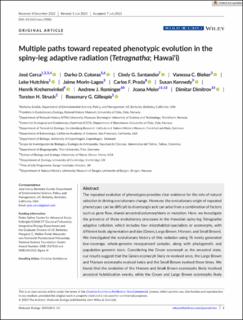Multiple paths toward repeated phenotypic evolution in the spiny-leg adaptive radiation (Tetragnatha; Hawai'i)
| dc.contributor.author | Cerca, José | |
| dc.contributor.author | Cotoras, Darko | |
| dc.contributor.author | Santander, Cindy G. | |
| dc.contributor.author | Bieker, Vanessa Carina | |
| dc.contributor.author | Hutchins, Leke | |
| dc.contributor.author | Morin-Lagos, Jaime | |
| dc.contributor.author | Prada, Carlos | |
| dc.contributor.author | Kennedy, Susan M. | |
| dc.contributor.author | Krehenwinkel, Henrik | |
| dc.contributor.author | Rominger, Andrew J. | |
| dc.contributor.author | Meier, Joana Isabel | |
| dc.contributor.author | Dimitrov, Dimitar | |
| dc.contributor.author | Struck, Torsten H | |
| dc.contributor.author | Gillespie, Rosemary G | |
| dc.date.accessioned | 2023-08-18T12:20:08Z | |
| dc.date.available | 2023-08-18T12:20:08Z | |
| dc.date.created | 2023-08-15T10:48:20Z | |
| dc.date.issued | 2023 | |
| dc.identifier.issn | 0962-1083 | |
| dc.identifier.uri | https://hdl.handle.net/11250/3084842 | |
| dc.description.abstract | The repeated evolution of phenotypes provides clear evidence for the role of natural selection in driving evolutionary change. However, the evolutionary origin of repeated phenotypes can be difficult to disentangle as it can arise from a combination of factors such as gene flow, shared ancestral polymorphisms or mutation. Here, we investigate the presence of these evolutionary processes in the Hawaiian spiny-leg Tetragnatha adaptive radiation, which includes four microhabitat-specialists or ecomorphs, with different body pigmentation and size (Green, Large Brown, Maroon, and Small Brown). We investigated the evolutionary history of this radiation using 76 newly generated low-coverage, whole-genome resequenced samples, along with phylogenetic and population genomic tools. Considering the Green ecomorph as the ancestral state, our results suggest that the Green ecomorph likely re-evolved once, the Large Brown and Maroon ecomorphs evolved twice and the Small Brown evolved three times. We found that the evolution of the Maroon and Small Brown ecomorphs likely involved ancestral hybridization events, while the Green and Large Brown ecomorphs likely evolved through novel mutations, despite a high rate of incomplete lineage sorting in the dataset. Our findings demonstrate that the repeated evolution of ecomorphs in the Hawaiian spiny-leg Tetragnatha is influenced by multiple evolutionary processes. | en_US |
| dc.language.iso | eng | en_US |
| dc.publisher | Wiley | en_US |
| dc.rights | Navngivelse-Ikkekommersiell 4.0 Internasjonal | * |
| dc.rights.uri | http://creativecommons.org/licenses/by-nc/4.0/deed.no | * |
| dc.title | Multiple paths toward repeated phenotypic evolution in the spiny-leg adaptive radiation (Tetragnatha; Hawai'i) | en_US |
| dc.type | Journal article | en_US |
| dc.type | Peer reviewed | en_US |
| dc.description.version | publishedVersion | en_US |
| dc.rights.holder | Copyright 2023 The Author(s) | en_US |
| cristin.ispublished | true | |
| cristin.fulltext | original | |
| cristin.qualitycode | 2 | |
| dc.identifier.doi | https://doi.org/10.1111/mec.17082 | |
| dc.identifier.cristin | 2167001 | |
| dc.source.journal | Molecular Ecology | en_US |
| dc.relation.project | Sigma2: NS9408K | en_US |
| dc.relation.project | Sigma2: NN9408K | en_US |
| dc.identifier.citation | Molecular Ecology. 2023. | en_US |
Tilhørende fil(er)
Denne innførselen finnes i følgende samling(er)
-
Department of Natural History [296]
-
Registrations from Cristin [9676]

